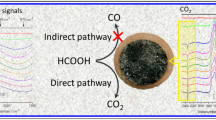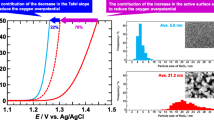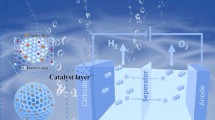Abstract
RuO2 is an unparalleled electrode with wider applications. Chloride, bound water, and surface stoichiometry are the inherent residues of RuO2 left upon the high-temperature pyrolysis of a RuCl3⋅xH2O precursor. Although the electrocatalytic properties of RuO2 for specific applications have been studied extensively, there is a paucity of studies linking the intrinsic electron-transfer (ET) activity of RuO2 with the oxide preparation temperature-dependent inherent residual parameters. This paper presents the intrinsic ET activity-oxide residue correlations for RuO2 electrodes. The ET kinetic parameters were estimated using a surface oxide-sensitive Fe3+/Fe2+ redox probe by rotating disc electrode voltammetry. Oxide powder-based electrodes (RuO2 powder-PVC/Pt-modified electrodes), which were fabricated conveniently at room temperature even with high-temperature oxides, were used instead of the traditional thermally prepared electrodes to circumvent the primary problems at the coating|support interface and inefficient chloride removal. RuO2 powders prepared at five temperatures (Tprep), i.e., 300, 400, 500, 600, and 700 °C, were used for electrode fabrication. The results showed that the electron exchange rate was highest for the 400 °C RuO2 electrode, and it was independent of the Tprep in the range 500 to 700 °C. The oxide powders were characterized using a range of techniques. The measured intrinsic ET activity and the associated structural correlation over the Tprep range 300–700 °C suggest that the best activity of the 400 °C electrode can be attributed to the optimal chloride and bound water contents in a completely formed rutile surface layer containing the catalyst sites of a particular nature with the highest electroactivity.









Similar content being viewed by others
References
Over H (2012) Surface chemistry of ruthenium dioxide in heterogeneous catalysis and electrocatalysis: from fundamental to applied research. Chem Rev 112:3356–3426
Trasatti S (1994) In: Lipkowski J, Ross PN (eds) The electrochemistry of novel materials. New York, VCH
Panic VV, Dekanski AB, Vidakovic TR, Miskovic-Stankovic VB, Javanovic BZ, Nikolic BZ (2005) Oxidation of phenol on RuO2-TiO2 anodes. J Solid State Electrochem 9(1):43–54
Popic JP, Avramov-Ivic ML, Vukovic NB (1997) Reduction of carbon dioxide on ruthenium oxide and modified ruthenium oxide electrodes in 0.5 M NaHCO3. J Electroanal Chem 421(1–2):105–110
Bergmann H, Koparal S (2005) The formation of chlorine dioxide in the electrochemical treatment of drinking water for disinfection. Electrochim Acta 50(25–26):5218–5228
Wang H, Wang JL (2008) The cooperative electrochemical oxidation of chlorophenols in anode–cathode compartments. J Hazard Mater 154(1–3):44–50
Zhuiykov S (2008) Morphology and sensing characteristics of nanostructured RuO2 electrodes for integrated water quality monitoring sensors. Electrochem Commun 10(6):839–843
Chandrasekara Pillai K, Senthil Kumar A, Zen J-M (2000) Nafion–RuO2–Ru(bpy)3 2+ composite electrodes for efficient electrocatalytic water oxidation. J Mol Cat A Chem 160(2):277–285
Yamane S, Kato N, Kojima S, Imanishi A, Ogawa S, Yoshida N, Nonomura S, Nakato Y (2009) Efficient solar water splitting with a composite “n-Si/p-CuI/n-i-p a-Si/n-p GaP∕RuO2” semiconductor electrode. J Phys Chem C 113(32):14575–14581
Puthiyapura VK, Pasupathi S, Basu S, Wu X, Su H, Varagunapandiyan N, Pollet B, Scott K (2013) RuxNb1LxO2 catalyst for the oxygen evolution reaction in proton exchange membrane water electrolysers. Int J Hydrog Energy 38(21):8605–8616
Zheng JP, Tiwari V (2017) Deposition of Pt and Pt-Ru nanoparticles on RuO2.xH2O using microwave method for direct methanol fuel cells. J Clean Energy Tech 5(3):183–187
Jung SH, Kim DH, Brüner P, Lee H, Hah HJ, Kim SK, Jung YS (2017) Extremely conductive RuO2-coated LiNi0.5Mn1.5O4 for lithium-ion batteries. Electrochim Acta 232:236–243
Balach J, Jaumann T, Mühlenhoff S, Eckert J, Giebeler L (2016) Enhanced polysulphide redox reaction using a RuO2 nanoparticle-decorated mesoporous carbon as functional separator coating for advanced lithium–sulphur batteries. Chem Commun 52(52):8134–8137
Gobal F, Faraji M (2015) RuO2/MWCNT/ stainless steel mesh as a novel positive electrode in vanadium redox flow batteries. RSC Adv 5(84):68378–68384
Han ZJ, Pineda S, Murdock AT, Seo DH, Ostrikov K, Bendavid A (2017) RuO2-coated vertical graphene hybrid electrodes for high-performance solid-state supercapacitors. J Mater Chem A 5(33):17293–17301
Lenz J, Trieu V, Hempelmann V, Kuhn A (2011) Ordered macroporous ruthenium oxide electrodes for potentiometric and amperometric sensing applications. Electroanalysis 23(5):1186–1192
Wu J, Suls J, Sansen W (2000) Amperometric determination of ascorbic acid on screen-printing ruthenium dioxide electrode. Electrochem Commun 2(2):90–93
Ishiju T, Chipwan DW, Takahashi T, Takahashi K (2001) Amperometric sensor for monitoring of dissolved carbon dioxide in sea water. Sensors Actuators B Chem 76(1–3):265–269
Shankara Narayanan J, Anjalidevi C, Dharuman V (2013) Nonenzymatic glucose sensing at ruthenium dioxide–poly(vinyl chloride)–Nafion composite electrode. J Solid State Electrochem 17(4):937–947
Galizzioli D, Tantardini F, Trasatti S (1975) Ruthenium dioxide: a new electrode material. II. Non-stoichiometry and energetics of electrode reactions in acid solutions. J App Electrochem 5(3):203–214
Savinell RF, Zeller RL III, Adams JA (1990) Electrochemically active surface area—voltammetric charge correlations for ruthenium and iridium dioxide electrodes. J Electrochem Soc 137:489–494
Ferro S, Urgeghe C, De Battisti A (2004) Heterogeneous electron-transfer rate constants for Fe(H2O)6 3+/2+ at metal oxide electrodes. J Phys Chem B 108:6398–6401
Parker JF, Kamm GE, McGovern AD, DeSario PA, Rolison DR, Lytle JC, Long JW (2017) Rewriting electron-transfer kinetics at pyrolytic carbon electrodes decorated with nanometric ruthenium oxide. Langmuir 33(37):9416–9425
Vercesi GP, Rolewicz J, Comninellis C (1991) Characterization of DSA-type oxygen evolving electrodes. Choice of base metal. Thermochim Acta 176:31–47
Pizzini S, Buzzanca G, Mari C, Rossi L, Torchio S (1972) Preparation, structure and electrical properties of thick ruthenium dioxide films. Mater Res Bull 7(5):449–462
Lodi G, Bighi C, de Asmundis C (1976) Deposition and characterization of RuO2 films on various substrates. Mater Chem 1(2):177–187
Lodi G, Zucchini C, de Battisti A, Sivieri E, Trasatti S (1978) On some debated aspects of the behaviour of RuO2 film electrodes. Mater Chem 3(3):179–188
Panić VV, Dekanski AB, Mišković-Stanković VB, Milonjić SK, Nikolić BZ (2003) The role of titanium oxide concentration profile of titanium oxide of RuO2-TiO2 coatings obtained by the sol-gel procedure on its electrochemical behavior. J Serb Chem Soc 68:979–988
Panić V, Dekanski A, Mišković-Stanković VB, Milonjić S, Nikolić B (2005) On the deactivation mechanism of RuO2–TiO2/Ti anodes prepared by the sol–gel procedure. J Electroanal Chem 579(1):67–76
Ferro S, De Battisti A (2002) Electrocatalysis and chlorine evolution reaction at ruthenium dioxide deposited on conductive diamond. J Phys Chem B 106(9):2249–2254
Ardizzone S, Fregonara G, Trasatti S (1990) “Inner” and “outer” active surface of RuO2 electrodes. Electrochim Acta 35(1):263–276
Weston JE, Steele BCH (1980) Proton diffusion in crystalline ruthenium dioxide. J Appl Electrochem 10(1):49–53
Allhusen JS, Conboy JC (2013) Preparation and characterization of conductive and transparent ruthenium dioxide sol−gel films. ACS Appl Mater Interfaces 5(22):11683–11691
Patake VD, Lokhande CD, Joo OS (2009) Electrodeposited ruthenium oxide thin films for supercapacitor: effect of surface treatments. Appl Sur Sci 255(7):4192–4196
Zhao G, Zhang L, Sun K, Li H (2014) Free-standing Pt@RuO2.xH2O nanorod arrays on Si wafers as electrodes for methanol electro-oxidation. J Power Sources 245:892–897
Senthil Kumar A, Chandrasekara Pillai K (2000) Studies of electrochemical of RuO2-PVC film electrodes: dependence on oxide preparation temperature. J Solid State Electrochem 4(7):408–416
Dharuman V, Chandrasekara Pillai K (1997) Glucose oxidation at Pt/PVC-bonded RuO2 composite electrode. Indian J Chem Technol 4:25–28
Dharuman V, Chandrasekara Pillai K (1999) Oxidation of D-glucose at RuO2-PVC paste electrode in 1M NaOH—dependence on oxide preparation temperature. Bull Electrochem 15:476–480
Dharuman V, Chandrasekara Pillai K (2006) RuO2 electrode surface effects in electrocatalytic oxidation of glucose. J Solid State Electrochem 10(12):967–979
Levich VG (1972) Physicochemical hydrodynamics. Prentice-Hall, Englewood Cliffs
Chen P, McCreery RL (1996) Control of electron transfer kinetics at glassy carbon electrodes by specific surface modification. Anal Chem 68(22):3958–3965
Randles JEB (1959) The determination of kinetic parameters of redox reactions from current-potential curves. Can J Chem 37(1):238–246
Tanaee H, Fukushima S (1984) Effect of surface structure on the electrochemical properties of Ni-metal complex oxide film electrode. Electrochim Acta 29(9):1173–1179
Conway BE (1991) Transition from “supercapacitor” to “battery” behavior in electrochemical energy storage. J Electrochem Soc 138(6):1539–1548
Zengh JP, Cygan CJ, Jow TR (1995) Hydrous ruthenium oxide as an electrode material for electrochemical capacitors. J Electrochem Soc 142:2699–2703
Ilangovan G, Chandrasekara Pillai K (1997) Electrochemical and XPS characterization of glassy carbon electrode surface effects on the preparation of a monomeric molybdate(VI)-modified electrode. Langmuir 13(3):566–575
McKeown DA, Hagans PL, Carette LPL, Russell AE, Swider KE, Rolison DR (1999) Structure of hydrous ruthenium oxides: implications for charge storage. J Phys Chem B 103(23):4825–4832
Mills A, McMurray N (1988) Characterisation of an RuO2·xH2O colloid and evaluation of its ability to mediate the oxidation of water. J Chem Soc Far Trans I 84(2):379–390
Long JW, Swider KE, Merzbacher CI, Rolison DR (1999) Voltammetric characterization of ruthenium oxide-based aerogels and other RuO2 solids: the nature of capacitance in nanostructured materials. Langmuir 15(3):780–785
Nakamoto K (1963) Infrared spectra of inorganic coordination compounds. Wiley, New York
Yukhnevich GV (1963) Advances in application of infrared spectroscopy to characterisation of OH bonds. Russ Chem Rev 32(11):619–633
Hameka HF, Jensen JO, Kay JG, Rosenthal CM, Zimmerman GL (1991) Theoretical prediction of geometries and vibrational infrared spectra of ruthenium oxide molecules. J Mol Spectros 150(1):218–221
McEvoy AJ, Gissler W (1982) ESCA spectra and electronic properties of some ruthenium compounds. Phys Stat Sol (A) 69(1):K91–K96
Augustynski J, Balsenc L, Hinden J (1978) X-ray photoelectron spectroscopic studies of RuO2-based film electrodes. J Electrochem Soc 125(7):1093–1097
Atanasoska LJ, O’Grady WE, Atanasoski RT, Pollak FH (1988) The surface structure of RuO2: a leed, auger and XPS study of the (110) and (100) faces. Sur Sci 202:142–166
Rolison DR, Hagans PL, Swider KE, Long JW (1999) Role of hydrous ruthenium oxide in Pt-Ru direct methanol fuel cell anode electrocatalysts: the importance of mixed electron/proton conductivity. Langmuir 15(3):774–779
Fletcher JM, Gardner WE, Greenfield BF, Holdoway MJ, Rand MH (1968) Magnetic and other studies of ruthenium dioxide and its hydrate. J Chem Soc A 0:653–657
Trasatti S (1991) Physical electrochemistry of ceramic oxides. Electrochim Acta 36(2):225–241
Scholz F (2002) Electroanalytical methods: guide to experiments and applications. Springer, Berlin
Etman M, Levart E, Schumann D (1979) Convective-diffusion impedance for a partially blocked rotating-disc electrode. J Electroanal Chem 101(2):141–152
Caprani A, Frayer JP (1982) Interactions between oxygen reduction and titanium dissolution in aerated hydrochloric acid: topographic implications. J Electroanal Chem 138(1):155–176
Weber J, Samec Z, Mareček V (1978) The effect of anion adsorption on the kinetics of the reaction on Pt and Au electrodes in HClO4. J Electroanal Chem 89(2):271–288
Weaver MJ, Anson FC (1975) Double-layer effects on simple electrode reactions. II The effects of specifically adsorbed anions and ion-pairing on the reduction of Eu3+ and Cr3+. J Electroanal Chem 65(2):737–758
Wang Y, Wöll C (2017) IR spectroscopic investigations of chemical and photochemical reactions on metal oxides: bridging the materials gap. Chem Soc Rev 46(7):1875–1932
Acknowledgements
K.C.P thanks the Korea Federation of Science and Technology Societies (KOFST, Republic of Korea) for the offer of Invited Scientist through the ‘Brain Pool Program’.
Funding
This study was supported by the National Research Foundation of Korea (NRF) funded by the Korea government (MEST) (Grant No. 2017R1A2A1A05001484) and the Council of Scientific and Industrial Research (CSIR), Government of India.
Author information
Authors and Affiliations
Corresponding authors
Electronic supplementary material
ESM 1
(DOC 828 kb)
Rights and permissions
About this article
Cite this article
Pillai, K.C., Kumar, A.S. & Moon, IS. Combined effect of inherent residual chloride and bound water content and surface morphology on the intrinsic electron-transfer activity of ruthenium oxide. J Solid State Electrochem 22, 2183–2196 (2018). https://doi.org/10.1007/s10008-018-3917-z
Received:
Revised:
Accepted:
Published:
Issue Date:
DOI: https://doi.org/10.1007/s10008-018-3917-z




